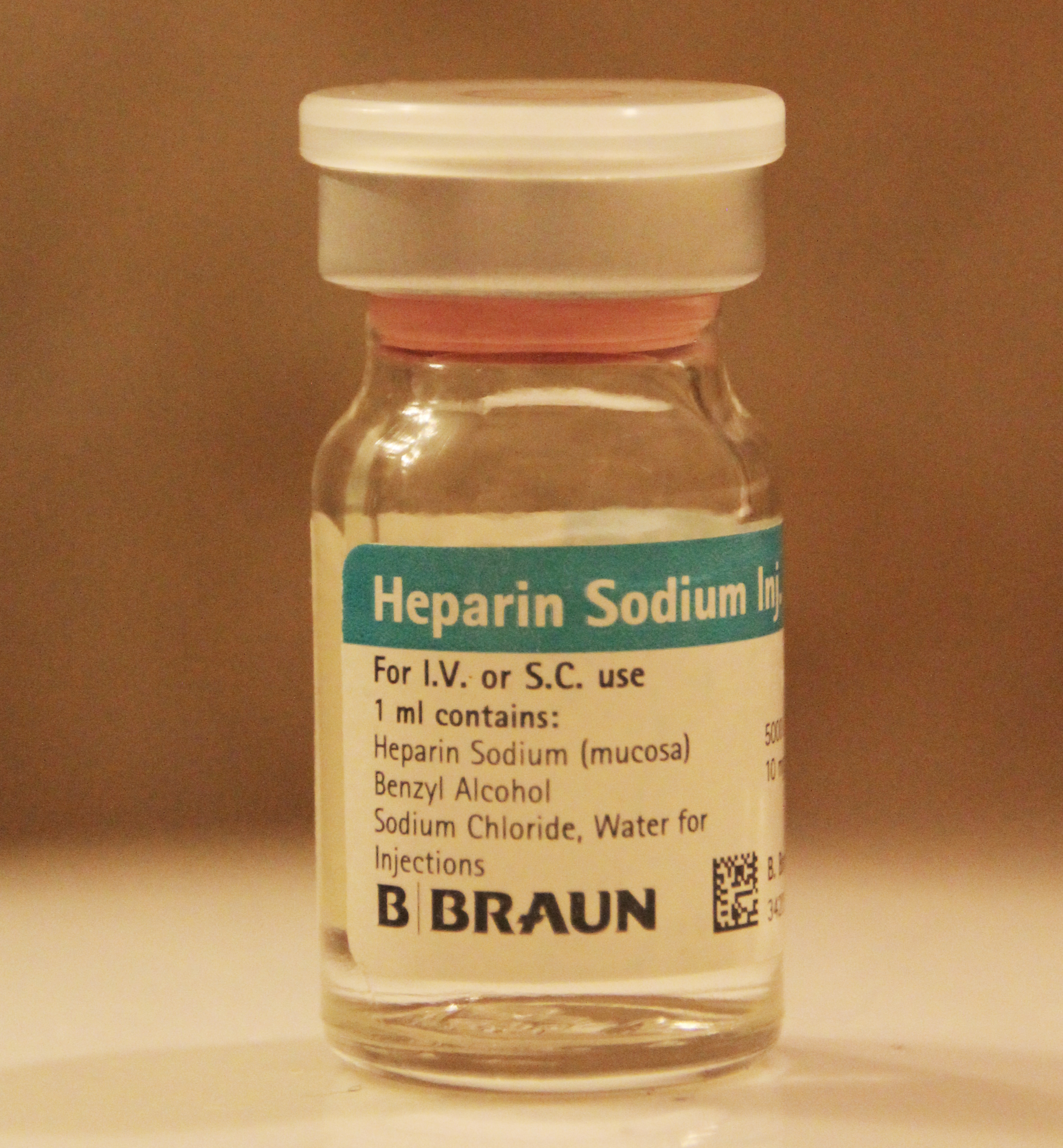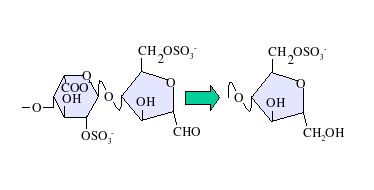|
Heparin
Heparin, also known as unfractionated heparin (UFH), is a medication and naturally occurring glycosaminoglycan. Heparin is a blood anticoagulant that increases the activity of antithrombin. It is used in the treatment of myocardial infarction, heart attacks and unstable angina. It can be given intravenously or by subcutaneous injection, injection under the skin. Its anticoagulant properties make it useful to prevent blood clotting in blood specimen test tubes and kidney dialysis machines. Common side effects include bleeding, pain at the injection site, and thrombocytopenia, low blood platelets. Serious side effects include heparin-induced thrombocytopenia. Greater care is needed in those with poor kidney function. Heparin is contraindicated for suspected cases of Post-vaccination embolic and thrombotic events, vaccine-induced pro-thrombotic immune thrombocytopenia (VIPIT) secondary to SARS-CoV-2 vaccination, as heparin may further increase the risk of bleeding in an anti-PF4 ... [...More Info...] [...Related Items...] OR: [Wikipedia] [Google] [Baidu] |
Antithrombin
Antithrombin (AT) is a small glycoprotein that inactivates several enzymes of the coagulation system. It is a 464-amino-acid protein produced by the liver. It contains three disulfide bonds and a total of four possible glycosylation sites. α-Antithrombin is the dominant form of antithrombin found in blood plasma and has an oligosaccharide occupying each of its four glycosylation sites. A single glycosylation site remains consistently un-occupied in the minor form of antithrombin, β-antithrombin. Its activity is increased manyfold by the anticoagulant drug heparin, which enhances the binding of antithrombin to thrombin, factor IIa (thrombin) and factor Xa. Structure Antithrombin is also termed antithrombin III (AT III). The designations antithrombin I through to antithrombin IV originate in early studies carried out in the 1950s by Seegers, Johnson and Fell. Antithrombin I (AT I) refers to the binding of thrombin to fibrin, after thrombin has activated fibrinogen, at a non-ca ... [...More Info...] [...Related Items...] OR: [Wikipedia] [Google] [Baidu] |
Heparin-induced Thrombocytopenia
Heparin-induced thrombocytopenia (HIT) is the development of thrombocytopenia (a low platelet count), due to the administration of various forms of heparin, an anticoagulant. HIT predisposes to thrombosis (the abnormal formation of blood clots inside a blood vessel). When thrombosis is identified the condition is called heparin-induced thrombocytopenia and thrombosis (HITT). HIT is caused by the formation of abnormal antibodies that activate platelets, which release microparticles that activate thrombin, leading to thrombosis. If someone receiving heparin develops new or worsening thrombosis, or if the platelet count falls, HIT can be confirmed with specific blood tests. The treatment of HIT requires stopping heparin treatment, and both protection from thrombosis and choice of an agent that will not reduce the platelet count any further. Several alternatives are available for this purpose; mainly used are danaparoid, fondaparinux, argatroban, and bivalirudin. While purified h ... [...More Info...] [...Related Items...] OR: [Wikipedia] [Google] [Baidu] |
Low Molecular Weight Heparin
Low-molecular-weight heparin (LMWH) is a class of anticoagulant medications. They are used in the prevention of Thrombosis prevention, blood clots and, in the treatment of venous thromboembolism (deep vein thrombosis and pulmonary embolism), and the treatment of myocardial infarction. Heparin is a naturally occurring polysaccharide that inhibits coagulation, preventing thrombosis. Natural heparin consists of molecular chains of varying lengths or molecular weights. Chains of varying molecular weights, from 5000 to over 40,000 Dalton (unit), daltons, make up polydisperse pharmaceutical-grade heparin. LMWHs, in contrast, consist of only short chains of polysaccharides. LMWHs are defined as heparin salts having an average molecular weight of less than 8000 Da and for which at least 60% of all chains have a molecular weight less than 8000 Da. Various methods of fractionation or depolymerisation, depolymerization of polymeric heparin obtain these. Heparin derived from natura ... [...More Info...] [...Related Items...] OR: [Wikipedia] [Google] [Baidu] |
Anticoagulant
An anticoagulant, commonly known as a blood thinner, is a chemical substance that prevents or reduces the coagulation of blood, prolonging the clotting time. Some occur naturally in blood-eating animals, such as leeches and mosquitoes, which help keep the bite area unclotted long enough for the animal to obtain blood. As a class of medications, anticoagulants are used in therapy for thrombotic disorders. Oral anticoagulants (OACs) are taken by many people in pill or tablet form, and various intravenous anticoagulant dosage forms are used in hospitals. Some anticoagulants are used in medical equipment, such as sample tubes, blood transfusion bags, heart–lung machines, and dialysis equipment. One of the first anticoagulants, warfarin, was initially approved as a rodenticide. Anticoagulants are closely related to antiplatelet drugs and thrombolytic drugs by manipulating the various pathways of blood coagulation. Specifically, antiplatelet drugs inhibit platelet agg ... [...More Info...] [...Related Items...] OR: [Wikipedia] [Google] [Baidu] |
Danaparoid
Danaparoid sodium (Orgaran) is an anticoagulant with an antithrombotic action due to inhibition of thrombin generation (TGI) by two mechanisms: indirect inactivation of Factor Xa via AT and direct inhibition of thrombin activation of Factor IX (an important feedback loop for thrombin generation). It also possesses a minor anti-thrombin activity, mediated equally via AT and Heparin Co-factor II producing a ratio of anti-Xa:IIa activity >22. [Meuleman DG. Haemostasis 1992;22:58-65 and Ofosu FA Haemostasis 1992;22:66-72] Danaparoid is a low molecular weight heparinoid devoid of heparin. It consists of a mixture of heparan sulfate, dermatan sulfate, and chondroitin sulfate. It is chemically distinct from heparin, has different protein-binding properties because of its low degree of sulphation and low surface charge density and thus has little cross-reactivity in heparin-intolerant patients. The TGI activity, considered by Fernandes et al. [Thromb Haemostas 1987;57/3:286-93] to provide ... [...More Info...] [...Related Items...] OR: [Wikipedia] [Google] [Baidu] |
Post-vaccination Embolic And Thrombotic Events
Post-vaccination embolic and thrombotic events, termed vaccine-induced immune thrombotic thrombocytopenia (VITT), vaccine-induced prothrombotic immune thrombocytopenia (VIPIT), thrombosis with thrombocytopenia syndrome (TTS), vaccine-induced immune thrombocytopenia and thrombosis (VITT), or vaccine-associated thrombotic thrombocytopenia (VATT), are rare types of blood clotting syndromes that were initially observed in a number of people who had previously received the Oxford–AstraZeneca COVID‑19 vaccine (AZD1222) during the COVID‑19 pandemic. It was subsequently also described in the Janssen COVID‑19 vaccine (Johnson & Johnson), leading to the suspension of its use until its safety had been reassessed. On 5 May 2022 the FDA posted a bulletin limiting the use of the Janssen Vaccine to very specific cases due to further reassessment of the risks of TTS, although the FDA also stated in the same bulletin that the benefits of the vaccine outweigh the risks. In April 2021, ... [...More Info...] [...Related Items...] OR: [Wikipedia] [Google] [Baidu] |
Erik Jorpes
Johan Erik Jorpes (born Johansson, 15 July 1894 – 10 July 1973) was a Finnish-born Swedish physician and biochemist. He identified the chemical structure of heparin and developed its clinical applications. Jorpes was the professor of medical chemistry in the Karolinska Institute in Stockholm in 1946–1963. Early life Erik Jorpes was born as Johan Erik Johansson to a poor fisherman's family in the village of Överboda in Kökar in Åland. The family lived in a house called ''Jorpes'', which he later adopted as his last name to replace the patronyme ''Johansson''. After the primary school, his parents send the talented kid to high school in Turku. Other students of the Swedish-language ''Svenska klassiska lyceum'' came mostly from wealthy upper-class families, Jorpes was bullied of his social status and dialect. As a result, Jorpes got interested in socialist ideas in the early 1910s. He joined the local Social Democratic student organization and wrote marxist articles to the ... [...More Info...] [...Related Items...] OR: [Wikipedia] [Google] [Baidu] |
Subcutaneous Injection
Subcutaneous administration is the insertion of medications beneath the skin either by injection or infusion. A subcutaneous injection is administered as a bolus (medicine), bolus into the subcutis, the layer of skin directly below the dermis and Epidermis (skin), epidermis, collectively referred to as the Cutis (anatomy), cutis. The instruments are usually a hypodermic needle and a syringe. Subcutaneous injections are highly effective in administering medications such as insulin, morphine, heroin, diacetylmorphine and goserelin. Subcutaneous administration may be List of medical abbreviations, abbreviated as SC, SQ, subcu, sub-Q, SubQ, or subcut. Subcut is the preferred abbreviation to reduce the risk of misunderstanding and potential errors. Subcutaneous tissue has few blood vessels and so drugs injected into it are intended for slow, sustained rates of absorption, often with some amount of depot injection, depot effect. Compared with other route of administration, routes of ad ... [...More Info...] [...Related Items...] OR: [Wikipedia] [Google] [Baidu] |
Glycosaminoglycan
Glycosaminoglycans (GAGs) or mucopolysaccharides are long, linear polysaccharides consisting of repeating disaccharide units (i.e. two-sugar units). The repeating two-sugar unit consists of a uronic sugar and an amino sugar, except in the case of the sulfated glycosaminoglycan keratan, where, in place of the uronic sugar there is a galactose unit. GAGs are found in vertebrates, invertebrates and bacteria. Because GAGs are highly polar molecules and attract water; the body uses them as lubricants or shock absorbers. Mucopolysaccharidoses are a group of metabolic disorders in which abnormal accumulations of glycosaminoglycans occur due to enzyme deficiencies. Production Glycosaminoglycans vary greatly in molecular mass, disaccharide structure, and sulfation. This is because GAG synthesis is not template driven, as are proteins or nucleic acids, but constantly altered by processing enzymes. GAGs are classified into four groups, based on their core disaccharide structures: # H ... [...More Info...] [...Related Items...] OR: [Wikipedia] [Google] [Baidu] |
Argatroban
Argatroban is an anticoagulant that is a small molecule direct thrombin inhibitor. In 2000, argatroban was licensed by the US Food and Drug Administration (FDA) for prophylaxis or treatment of thrombosis in people with heparin-induced thrombocytopenia (HIT). In 2002, it was approved for use during percutaneous coronary interventions in people who have HIT or are at risk for developing it. In 2012, it was approved by the UK Medicines and Healthcare products Regulatory Agency for anticoagulation in people with heparin-induced thrombocytopenia Type II (HIT) who require parenteral antithrombotic therapy. Argatroban is given intravenously and drug plasma concentrations reach steady state in 1–3 hours. Argatroban is metabolized in the liver and has a half-life of about 50 minutes. It is monitored by PTT. Because of its hepatic metabolism, it may be used in patients with renal dysfunction. (This is in contrast to lepirudin, a direct thrombin inhibitor that is primarily renally c ... [...More Info...] [...Related Items...] OR: [Wikipedia] [Google] [Baidu] |
Mast Cell
A mast cell (also known as a mastocyte or a labrocyte) is a resident cell of connective tissue that contains many granules rich in histamine and heparin. Specifically, it is a type of granulocyte derived from the myeloid stem cell that is a part of the immune and neuroimmune systems. Mast cells were discovered by Friedrich von Recklinghausen and later rediscovered by Paul Ehrlich in 1877. Although best known for their role in allergy and anaphylaxis, mast cells play an important protective role as well, being intimately involved in wound healing, angiogenesis, immune tolerance, defense against pathogens, and vascular permeability in brain tumors. The mast cell is very similar in both appearance and function to the basophil, another type of white blood cell. Although mast cells were once thought to be tissue-resident basophils, it has been shown that the two cells develop from different hematopoietic lineages and thus cannot be the same cells. Structure Mast cells ar ... [...More Info...] [...Related Items...] OR: [Wikipedia] [Google] [Baidu] |




